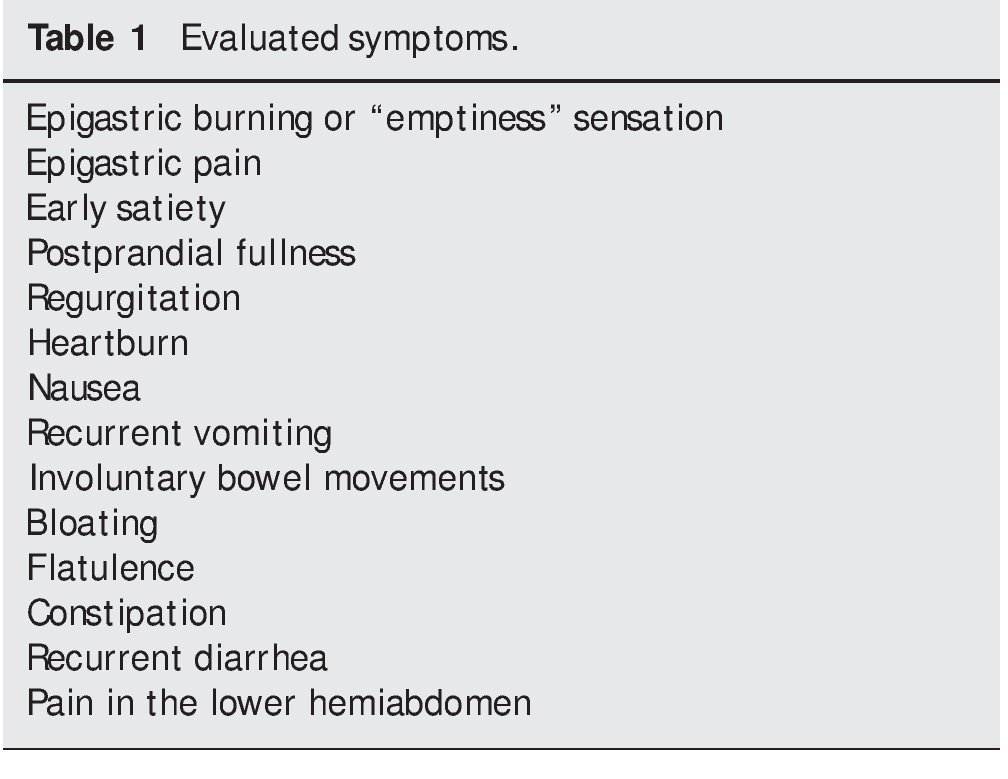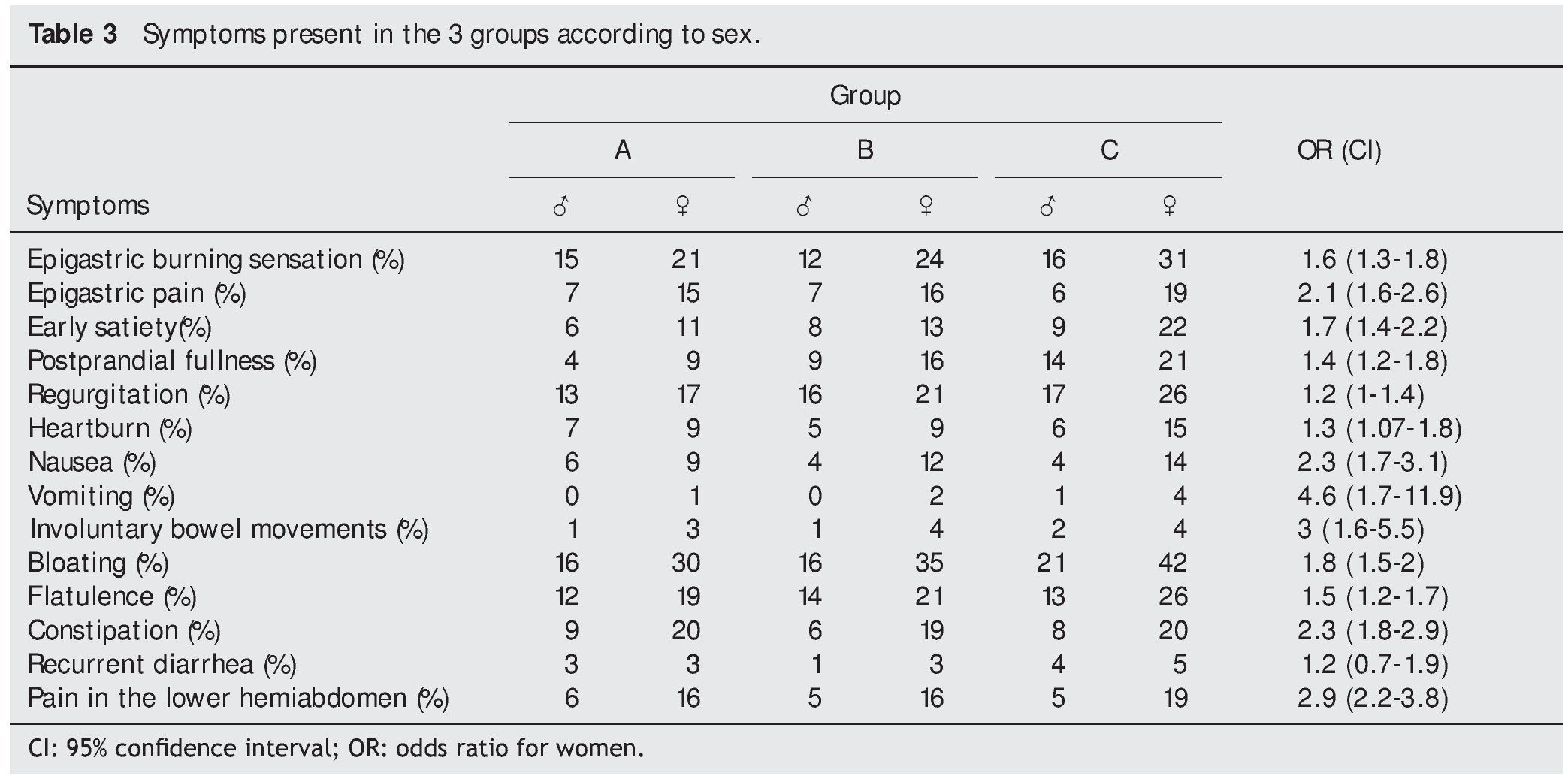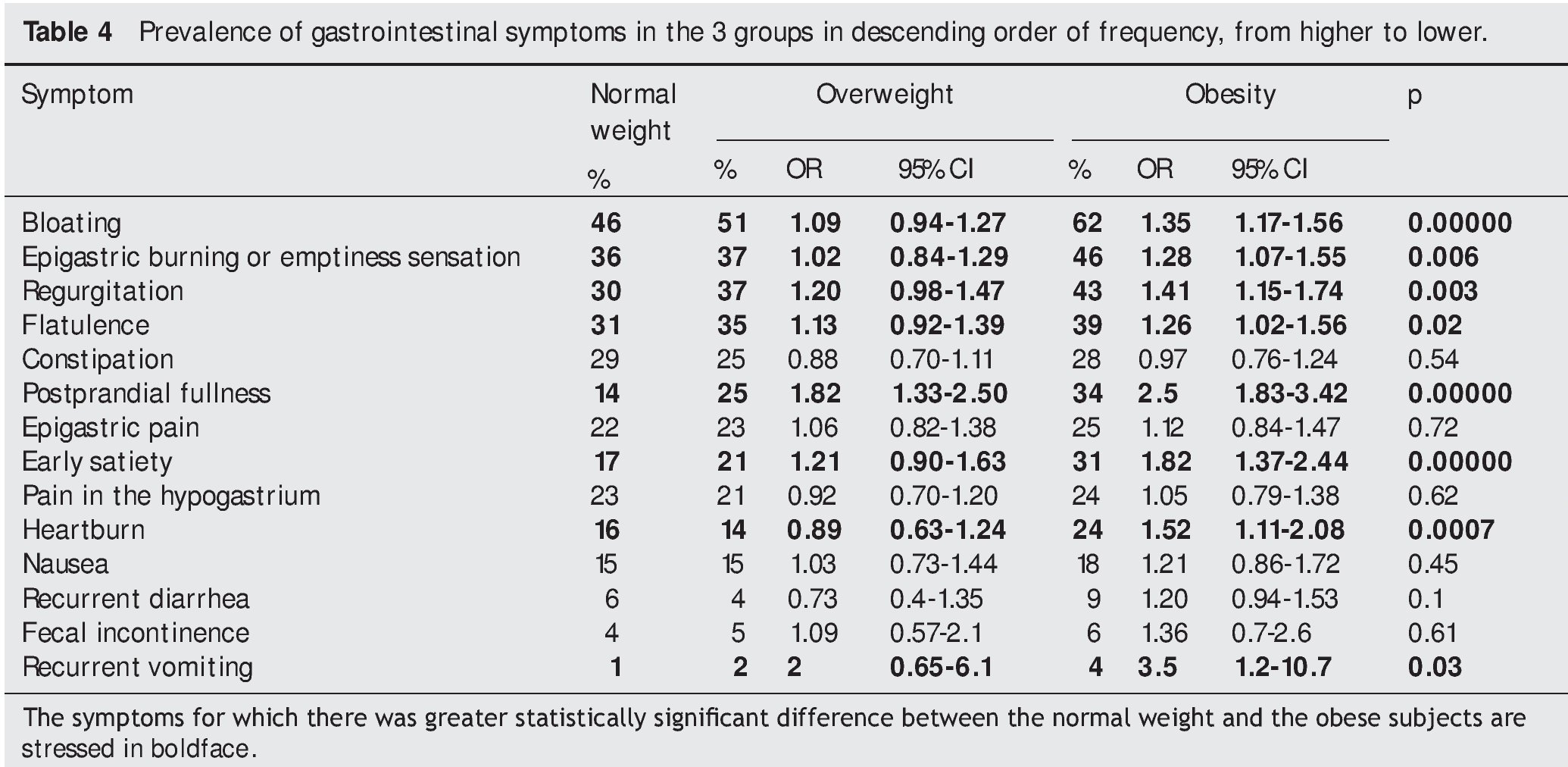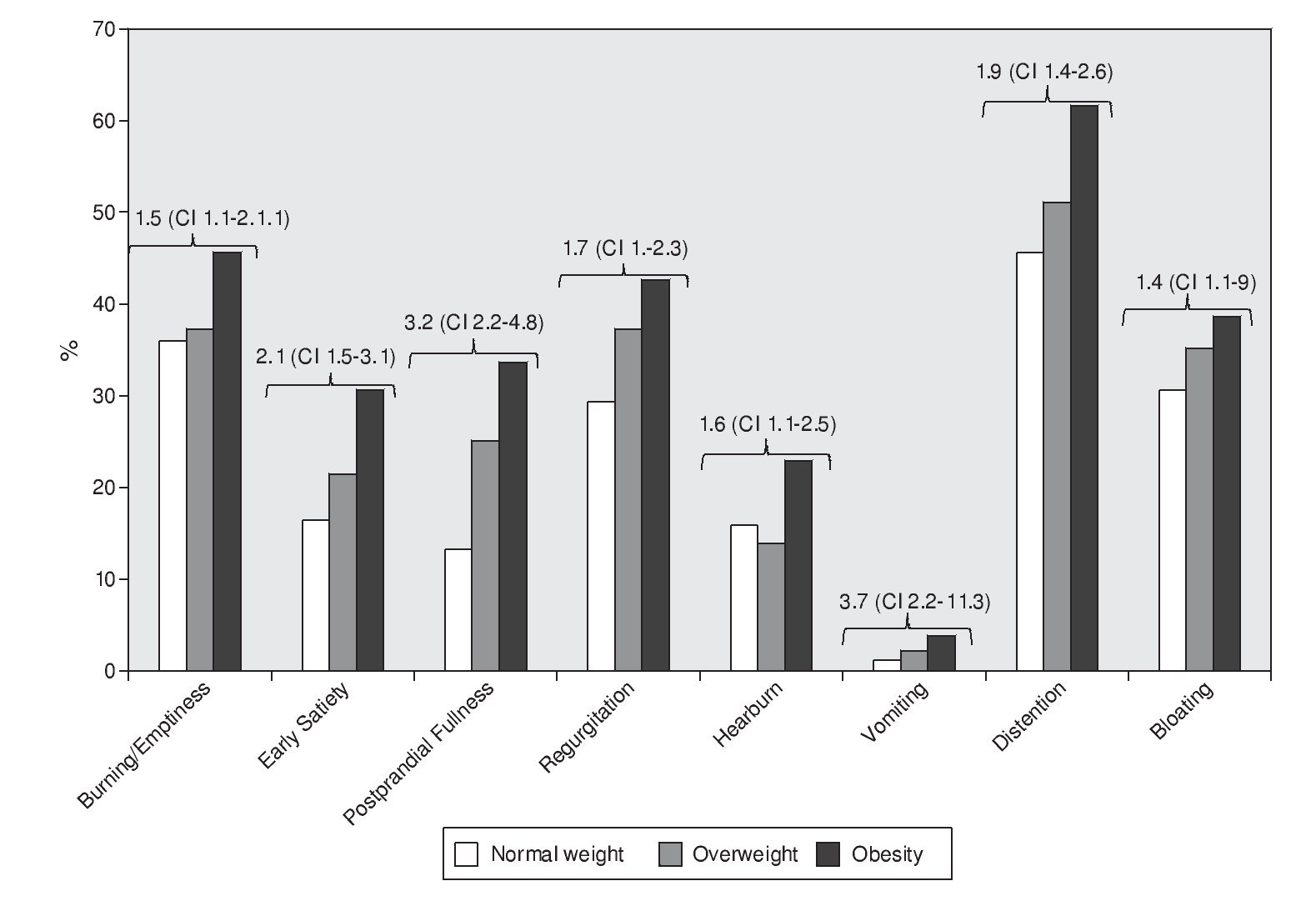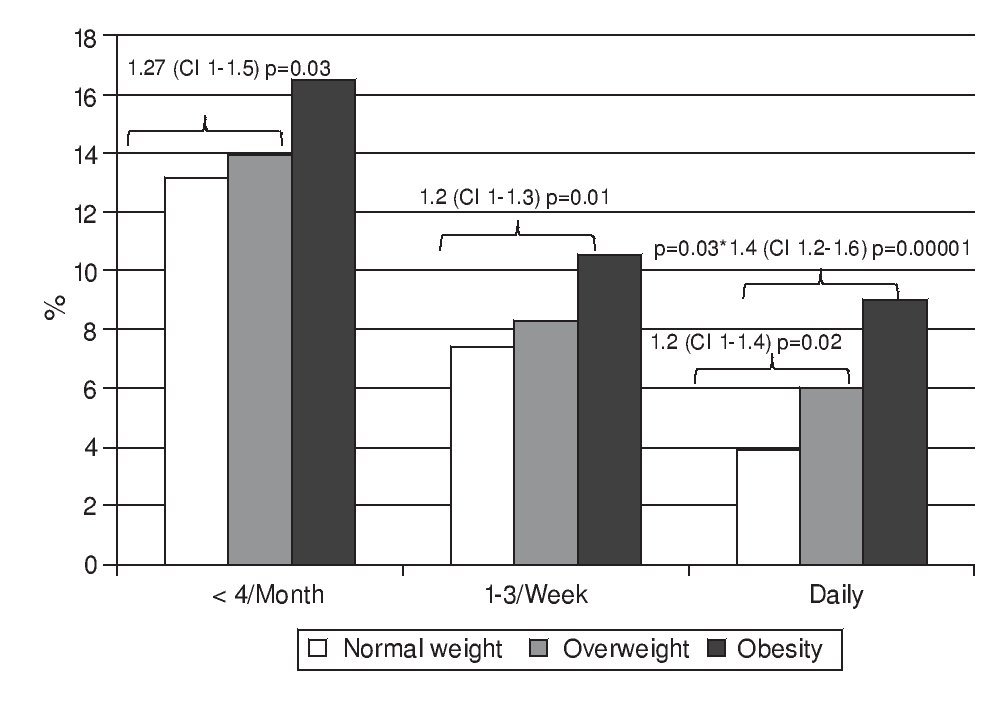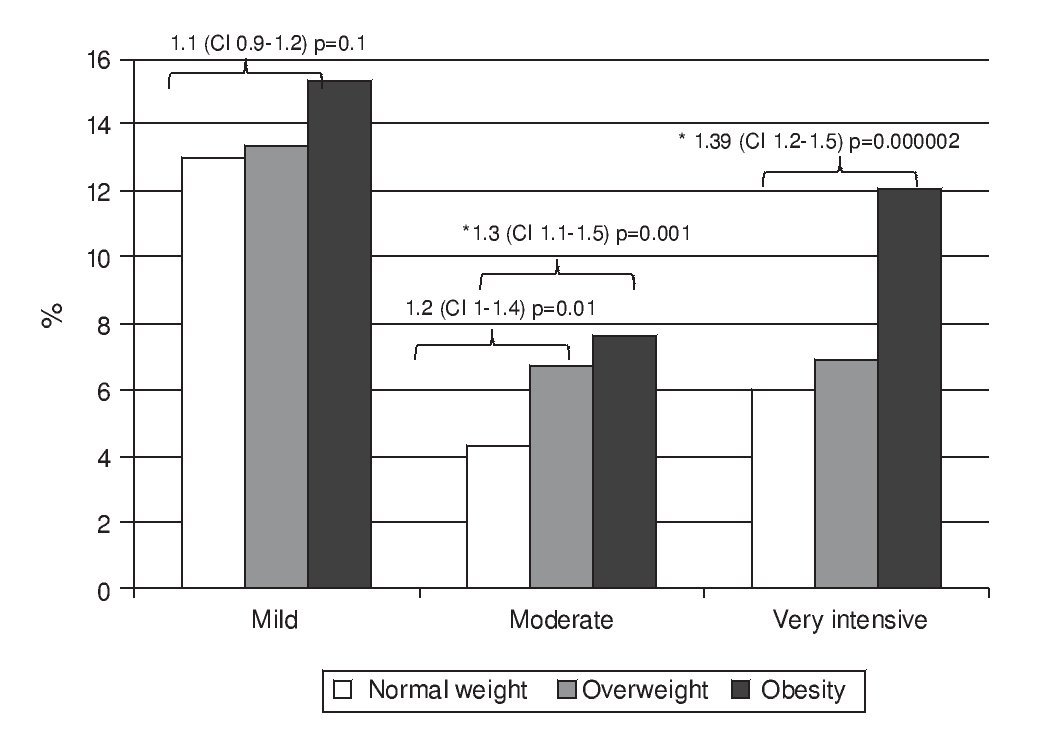Antecedentes: La prevalencia del sobrepeso y la obesidad están aumentando de manera importante. México ocupa uno de los primeros lugares a nivel mundial y se estima que más del 70% de nuestra población adulta está afectada. Las afecciones asociadas a la obesidad son múltiples y el aparato digestivo no es la excepción.
Objetivo: Investigar la prevalencia de síntomas gastrointestinales en personas con sobrepeso y obesidad en una muestra representativa de la población mexicana.
Métodos: Se realizó un estudio epidemiológico en 1,139 voluntarios, quienes se dividieron de acuerdo a su índice de masa corporal en 3 grupos: A: peso normal, B: sobrepeso, y C: obesidad, y se investigaron la prevalencia, la intensidad y la recurrencia de 14 síntomas gastrointestinales comunes mediante una encuesta dirigida. Se realizó un análisis comparativo con medidas de frecuencia y asociación, utilizando el paquete estadístico EPIDAT 3.1.
Resultados: La prevalencia de síntomas se incrementó con el aumento de peso; 8 de ellos (meteorismo, ardor epigástrico, regurgitaciones, flatulencia, plenitud posprandial tardía, plenitud precoz, pirosis y vómitos recurrentes) resultaron ser más prevalentes, más intensos y más frecuentes en personas obesas que en quienes tienen peso normal, con diferencias estadísticamente significativas (p = 0.0001).
Conclusiones: Los individuos con sobrepeso y obesidad tienen más síntomas gastrointestinales que aquellos con peso normal; al agrupar los síntomas más frecuentes, se observó que predominaron aquellos que son característicos de dispepsia, enfermedad por reflujo y mayor producción de gases intestinales.
Background: The prevalence of overweight and obesity is increasing significantly and Mexico is in a top position on a worldwide scale, with more than 70% of the adult population estimated to be affected. Multiple pathologies are associated with obesity and those of the digestive tract are no exception.
Aims: To study the prevalence of gastrointestinal symptoms in subjects with overweight and obesity in a representative sample of the Mexican population.
Methods: An epidemiologic study was conducted on 1,139 volunteers that were divided into three groups according to their body mass index: A) normal weight, B) overweight, and C) obese. The prevalence, intensity, and recurrence of 14 common gastrointestinal symptoms were studied through a guided survey. A comparative analysis with measures of frequency and association was carried out using the EPIDAT 3.1 statistical package.
Results: Symptom prevalence increased with weight gain; eight of the symptoms (bloating, epigastric burning sensation, regurgitations, flatulence, postprandial fullness, early satiety, heartburn and recurrent vomiting) were more prevalent, intense, and frequent in obese individuals than in those with normal weight, with statistically significant differences P=.0001).
Conclusions: Overweight and obese individuals have more gastrointestinal symptoms than those with normal weight; when the most frequent symptoms were grouped together, those characteristic of dyspepsia, reflux disease, and increased intestinal gas production predominated.
Introduction
Obesity is defined as excess body fat that is associated with a greater risk for disease and premature death.1 There are many ways to measure overweight and obesity. The World Health Organization and the National Institutes of Health of the United States recommend the body mass index (BMI) because of its considerable practicality and the fact that it can be applied to the majority of the population. With this tool, normal BMI for the adult has been determined at 18.5 to 24.9 kg/m2; overweight as a BMI between 25 and 29.9 kg/m2, and obesity as a BMI above 30 kg/m2.
Obesity and its complications are currently the primary cause of death in the world;2,3 it is alarming that its prevalence has been notably and steadily on the rise for 30 years. The social, health, and economic costs are significant and today's health system resources for dealing with this problem are insufficient; its tendency is epidemic. As long as 10 years ago, it was estimated that 300,000 persons would die annually from causes related to obesity and the direct and indirect costs surpassed the quantity of one hundred billion dollars.1 It has recently been published that the number of obese individuals worldwide may reach 400 million;4 in the United States alone, the percentage of obese adults has doubled from 1960 to 2004 and a calculated 32% of the population is affected today.5,6
The problem is even greater in Mexico. According to the 2006 National Health Survey, 40% of individuals over 20 years of age are overweight and 30% are obese.7 Close to 40% of school age children are overweight or obese and Mexico is now said to be in first place worldwide for childhood obesity.8
Diabetes mellitus (DM), high blood pressure (HBP), and tumors in different organs are among the main complications from obesity, and they involve almost the entire organism, including the digestive tract.
The digestive symptoms in over weight and obese patients have long been described and they are varied and frequent; among the most outstanding are a sensation of fullness, regurgitation, heartburn, and fecal urgency,9 and their originating pathologies are quite diverse. Nevertheless, despite the fact that overweight and obesity affect at least 70% of the adult Mexican population, there are very few national reports available and they have been conducted on small samples and very heterogeneous groups.
The primary aim of this study was to determine the prevalence of gastrointestinal symptoms in adults presenting with overweight and obesity and compare them with a similar group of normal weight adults. The secondary aim was to compare the intensity and frequency of those symptoms that presented in the 3 groups.
Methods
A survey was applied to residents of the city of Pachuca that were over 20 years of age to study the prevalence, frequency, and intensity of 14 common gastrointestinal symptoms (Table 1). According to their BMI (calculated with the conventional formula: BMI = kg/m2), the participants were divided into 3 groups: A, normal weight (BMI <25); B, overweight (BMI 25 to 29.9 kg/m2); and C, obese (BMI 30 kg/m2 or more).
Adult residents of Pachuca of both sexes that were over 20 years of age were enrolled in the study. They voluntarily accepted to participate in the study, giving their informed consent. Individuals with a BMI <18.5 kg/m2 were excluded, as well as those that, according to the evaluation, presented with an active episode of acute gastroenteritis, peptic ulcer, acute abdomen, a known gastrointestinal neoplasia, a history of esophageal, stomach, or intestinal surgery, a history of decompensated chronic diseases, or habitual or daily use of nonsteroidal anti¿inflammatory drugs, steroids, bronchodilators, anticholinergics, prokinetics, and/or tricyclic antidepressants.
All participants answered a survey that had been previous ly validated at our institution and the frequency and intensity of each of the symptoms present was determined; in order to do so each of the participants was asked to think of the habitual presentation of each symptom and grade its frequency according to one of the following three options: "less than 4 times a month", "1 to 3 times a week", and "daily or almost daily"; with regard to symptom intensity, the volunteers were asked to choose one of the following: "mild", "moderate" or "very intense".
Sample size
According to official figures, in Mexico 40% of the adults over 20 years of age present with overweight and 30% with obesity,7 and so we calculated the minimum sample size with the following formula:
Zc=1.96; p= Estimated obesity or overweight prevalence; q=1-p; d=0.05.
Thus we obtained minimums of 368 subjects for the overweight group and 322 for the obesity and the normal weight groups.
Statistical analysis
Using the EPIDAT 3.1 statistical package, a comparative analysis was done using measures of frequency and association to establish possible correlations between weight gain and a greater prevalence, recurrence, and intensity of gastrointestinal symptoms.
Results
A total of 1139 subjects were included in the study and distributed in the following manner: 332 in group A (normal BMI), 481 in group B (BMI overweight), and 336 in group C (BMI obesity). The 3 groups were formed according to the calculated minimum sample size and 3 comparative samples of age and sex were obtained. There were no differences in the demographic characteristics among the three groups (p>0.05) (Table 2). HBP prevalence was 6% (n=20), 12% (n=57), and 23% (n=76) in groups A, B, and C, respectively (p=0.00001). There was no statistically significant difference in DM prevalence: with 5%, 7%, and 8%, respectively (p>0.05).
The most frequent symptoms in the 3 groups were, epigastric burning sensation, constipation, regurgitation, and epigastric pain (Tables 3 and 4). It is striking that in the 3 groups studied, the frequency of the examined symptoms was greater in women than in men (Table 3). Figure 1 shows the prevalence of the 8 most frequently encountered gastrointestinal symptoms and the difference between groups. The recorded odds ratio and confidence intervals correspond to the comparison of the normal weight group vs. the obesity group, and there was statistically significant difference in all groups.
Figure 1. Prevalence of the 8 most frequently found gastrointestinal symptoms and difference between groups. The OR and confidence intervals listed correspond to the comparison of the normal weight group vs. the obesity group. There was statistically significant difference in all cases.
The difference was lower when the normal weight group and the overweight group were compared and there was no statistical significance in the majority of cases, with the exception of postprandial fullness, which showed a statistically significant difference (OR=1.82; 95% CI 1.33-2.5; p=0.001).
Table 4 shows the symptom frequency of the 3 groups in decreasing order. Figure 2 displays the frequency of the most common symptoms of the 3 groups, and symptoms are shown to be more frequent in group B and C subjects than in those of group A. Figure 3 describes the overall symptom intensity in the 3 groups, in which symptom intensity is seen to be greater in the overweight and obesity groups. Tables 5 and 6 present the frequency and intensity of each of the symptoms that were evaluated.
Figure 2. Comparison of the 3 groups in relation to presentation frequency of all symptoms. *Statistically significant difference.
Figure 3 Comparison of the 3 groups in relation to the intensity of all the symptoms. *Statistically significant difference.
Discussion
Overweight and obesity are increasingly affecting a larger group of the world population; in Mexico the estimated prevalence in adults is 70% and there is a wide variety of associated pathologies. The resulting cost of medical care is in the billions and the social, work, and quality of life deterioration is also significant.
There are many digestive symptoms and diseases that subjects with excess weight can present with; cholelithiasis10 and reflux disease11-14 are two frequent pathologies in the overweight and the obese patient, but they are not the only ones. For example, in relation to the colon, obesity has been related to diverticular disease and a greater prevalence of adenomas and cancer.15-18 In the pancreas, the progression of acute pancreatitis is more indolent and fatal in this group of patients,19,20 and the incidence of cancer is greater.21-23 In general terms, the incidence of cancer at different levels is also elevated in the obese patient.24
Nonalcoholic fatty liver disease (NAFLD) and its complications such as nonalcoholic steatohepatitis, cirrhosis, and hepatocarcinoma25,26 cannot be overlooked, because in the majority of cases NAFLD is associated with obesity and other components of the so-called "metabolic syndrome".
According to our findings, the association between digestive tract symptoms and diseases and overweight and obesity is clear. Our epidemiologic study shows that in a large population sample from the center of the country (1139 volunteers) not only was there a significant increase in prevalence in 8 of the 14 symptoms evaluated that rose in direct relation to BMI elevation, but also it was clearly shown that both the frequency and intensity of these gastrointestinal symptoms were directly proportional to the increase in BMI.
When we grouped the most prevalent symptoms of the obese patients together and did a detailed analysis, some that are common in dyspepsia stood out (epigastric pain or sensation of emptiness, early satiety, postprandial fullness, and vomiting); some are characteristic of gastroesophageal reflux disease (heartburn and regurgitation), while others are suggestive of greater intestinal gas production (bloating and flatulence), and constipation cannot be left out. Our results coincide with other studies that have reported a greater prevalence of dyspepsia and gastroesophageal reflux disease in overweight and obese subjects, and they coincide with a recently published meta-analysis27 that reviewed 21 studies with a total of 77,538 individuals that also pointed out the significant association between certain gastrointestinal symptoms and an increase in BMI.
It is noteworthy that even though the majority of gastrointestinal symptoms necessarily produce discomfort that is related to food intake, this does not seem to be a limiting factor in the obese patient. The mechanisms related to each and every symptom evaluated in the present study are not known, but it has been suggested that alterations in visceral sensitivity, gastrointestinal motility, and the microbiota can be determining factors.
Our study is a reflection of what occurs in a representative sample of a population in central Mexico, and it is probable that both symptom prevalence and obesity could have geographic variations.
In conclusion, this epidemiologic study showed that patients presenting with overweight and obesity had a greater frequency of digestive symptoms compared with subjects that had normal weight.
Financial disclosure
No financial support was received in relation to this study.
Conflict of interests
The authors declare that there is no conflict of interest.
Received 9 July 2012; accepted 3 October 2012
Available online 6 February 2013
qPlease cite this article as: Bernal-Reyes R, et al. Prevalencia de síntomas gastrointestinales en personas con sobrepeso y obesidad. Estudio epidemiológico en una población mexicana. Revista de Gastroenterología de México. 2013;78:24-34.
* Corresponding author at:
Justo Sierra No. 116, Col. Periodistas, Pachuca, Hidalgo, CP. 42060, Mexico.
Email address:raulber@yahoo.com (R. Bernal-Reyes).


